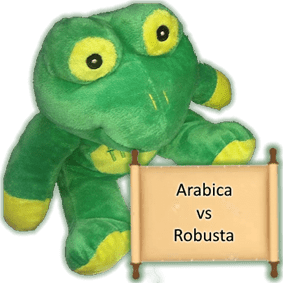Repost of fao… There are additional notes added to that post based on our own knowledge of the processing of coffee.
1. The Coffee Tree
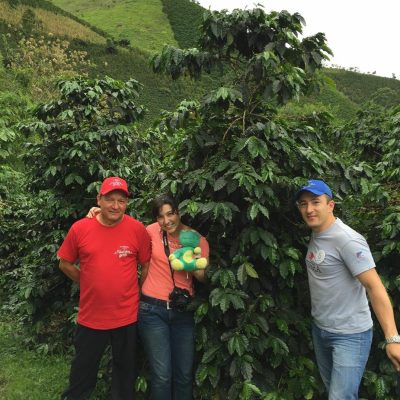 The coffee tree is a shrub with a straight trunk which can survive for about 70 years. The first flowers appear during the third year, but production is only profitable from the fifth year onwards. Botanists classify Coffee as a member of the Rubiaceous family. Of around sixty different species of coffee tree, two alone dominate world trade – the Coffee Arabica, or, more simply, Arabica, which represents 75% of production; and the Coffee canephora, which is commonly known by the name of the most widespread variety: Robusta.
The coffee tree is a shrub with a straight trunk which can survive for about 70 years. The first flowers appear during the third year, but production is only profitable from the fifth year onwards. Botanists classify Coffee as a member of the Rubiaceous family. Of around sixty different species of coffee tree, two alone dominate world trade – the Coffee Arabica, or, more simply, Arabica, which represents 75% of production; and the Coffee canephora, which is commonly known by the name of the most widespread variety: Robusta.
Arabica is autogamous, that is to say, capable of pollinating itself, whereas Robusta is allogamous, i.e. needs other trees to pollinate it.
2. The leaves of the coffee tree
The coffee tree is an evergreen with spear-shaped leaves, which are green and shiny on the upper side. As with all Rubiaceous plants, the leaves grow in pairs on either side of the stem. The leaves of the Robusta trees are much larger than those of the Arabica.
3. The cherry
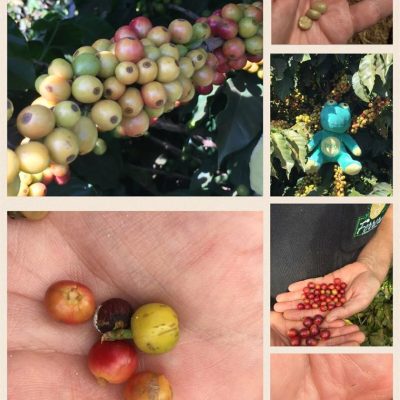 The cherry is the name usually given to the fruit of the coffee tree (Fig. 1). Green to begin with, the berries ripen over several months, becoming successively yellow, then red, garnet red, and finally almost black (this is the case for coffee that is Arabica typica, but some regions find it ripens at a dark orange).
The cherry is the name usually given to the fruit of the coffee tree (Fig. 1). Green to begin with, the berries ripen over several months, becoming successively yellow, then red, garnet red, and finally almost black (this is the case for coffee that is Arabica typica, but some regions find it ripens at a dark orange).
The ideal time for harvesting is when the berries are red. The red skin is called the exocarp. Beneath the pulp (the mesocarp), each surrounded by a parchment-like covering (the endocarp), lie two beans, flat sides together. When the fruit is ripe a thin, slimy layer of mucilage surrounds the parchment. Underneath the parchment the beans are covered in another thinner membrane, the silver skin (the seed coat). Each cherry generally contains two coffee beans; if there is only one it assumes a rounder shape and is known as a peaberry. Coffee beans must be removed from the fruit and dried before they can be roasted; this can be done in two ways, known as the dry and the wet methods. When the process is complete the unroasted coffee beans are known as green coffee.

4. Ecology
Coffee is a tropical plant which grows between the latitudes of 25 degree north and 25 degree south but requires very specific environmental conditions for commercial cultivation.
Temperature, rainfall, sunlight, wind and soils are all important, but requirements vary according to the varieties grown.
Ideal average temperatures range between 15 – 24 degree Celsius for Arabica coffee and 24 – 30 degree Celsius for Robusta, which can take hotter, drier conditions but does not tolerate temperatures much below 15 degree Celsius, as Arabica can for short periods. All coffee is easily damaged by frost, a danger either in southern Brazil or, closer to the Equator, at altitudes around 2000 metres.
In general, coffee needs an annual rainfall of 1500 to 3000 mm., Arabica needing less than other species. The pattern of rainy and dry periods is important for growth, budding and flowering. Rainfall requirements depend on the retention properties of the soil, atmospheric humidity and cloud cover, as well as cultivation practices.
Whereas Robusta coffee can be grown between sea level and about 800 metres, Arabica does best at higher altitudes and is often grown in hilly areas. As altitude relates to temperature, Arabica can be grown at lower levels further from the Equator, until limited by frost. All coffee needs good drainage, but it can grow on soils of different depths, pH and mineral content, given suitable applications of fertiliser.
5. Shading Protection
It was long thought that the coffee tree could not stand full sunlight exposure without damage, that is why early cultivation provided shade to the coffee tree resembling its natural habitat, forest.
Shade helps to protect the coffee trees from extreme winds and dryness. The ambient air temperature is uniform within the coffee trees making it cooler in the early parts of the day and warmer in the evening. The coolness, due to shading in the day reduces transpiration both from the leaves and the roots. Shade trees may also be used for erosion control on steep slopes.
Direct sunlight on the base of the plant can dry out and inhibit root growth, hence mulching and elimination of weeds is important.
The trend today is to use less and less shade but to supply the tree with increased amounts of both fertiliser and water. Under these conditions, they bear more heavily and still keep healthy.
6. Harvesting
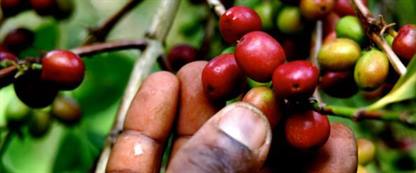
Eight to 9 months after flowering berries are ready for picking has taken. In most origins within only two weeks, all the plantations in a region can be covered in cherries and it is then essential to pick only the ripe berries, which are shiny, red and firm to the touch. Unripe green cherries, mixed with the others, will make the coffee more bitter; those which have turned garnet-red, violet or black are over-ripe and give the final product an unpleasant, acrid taste.
The best quality is obtained by picking the ripe berries one by one by hand.
6.1. Four ways of picking coffee berries
- handpicking: is the most expensive method because it is labour intensive, but it also gives the best results. The ripe cherries are picked by hand one by one throughout the year as many times as necessary.
- stripping method: consists of removing everything on the branch by hand: ripe cherries, flowers, unripe cherries, and black, over-ripe ones. This method produces poor results, but is nevertheless practised in some African regions and in Brazil.
- combing method: combing of the branch with a special flexible comb. The ripe cherries fall to the ground, but the leaves and green cherries are left intact on the tree.
- mechanical method: uses either mechanical vibrators fixed to the tree trunks, which cause the ripe fruit to fall to the ground, or tractors with rotating brushes, which, unfortunately, damage the trees by stripping off the flowers and leaves as well.
7. Processing of the Cherry into parchment coffee
Once the cherries are harvested, the beans have to be extracted by using either the dry or the wet method. The wet method is more expensive than the dry method, but the coffee it produces has better quality properties.
7.1. Dry Method
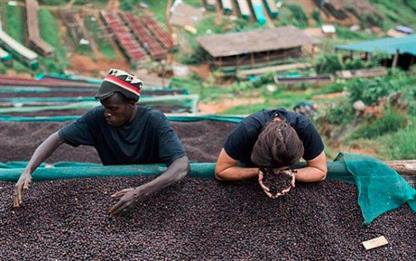
The dry method (also called the natural method) is the oldest, simplest and requires little machinery. The method involves drying the whole cherry. There are variations on how the process may be carried out, depending on the size of the plantation, the facilities available and the final quality desired. The three basic steps, cleaning, drying and hulling, are described below.
Firstly, the harvested cherries are usually sorted and cleaned, to separate the unripe, overripe and damaged cherries and to remove dirt, soil, twigs and leaves. This can be done by winnowing, which is commonly done by hand, using a large sieve. Any unwanted cherries or other material not winnowed away can be picked out from the top of the sieve. The ripe cherries can also be separated by flotation in washing channels close to the drying areas. The coffee cherries are then spread out in the sun, either on large concrete or brick patios or on matting raised to waist height wire mesh tables to dry. As the cherries dry, they are raked or turned by hand to ensure even drying. It may take up to 4 weeks before the cherries are dried to the optimum 11% moisture content, depending on the weather conditions. On larger plantations, machine drying is sometimes used to speed up the process after the coffee has been pre-dried in the sun for a few days.
The drying operation is the most important stage of the process, since it affects the final quality of the green coffee. A coffee that has been over-dried will become brittle and produce too many broken beans during hulling (broken beans are considered defective beans). Coffee that has not been dried sufficiently will be too moist and prone to rapid deterioration caused by the attack of fungi and bacteria.
The dried cherries are stored in bulk in special silos or in bags until they are sent to the mill where hulling, sorting, grading and bagging take place. All the outer layers of the dried cherry are removed in one step by the hulling machine.
The dry method is used for about 95% of the Arabica coffee produced in Brazil, some of the coffees produced in Ethiopia, Haiti and Paraguay, as well as for some Arabicas produced in India and Ecuador. Almost all Robustas are processed by this method. It is not practical in very rainy regions, where the humidity of the atmosphere is too high or where it rains frequently during harvesting.
7.2. Wet Method
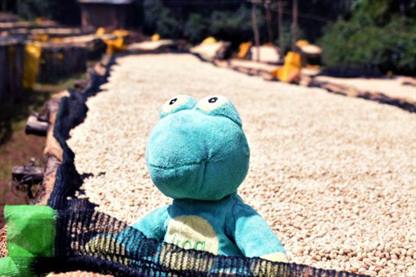
The wet method requires the use of specific equipment and substantial quantities of water (although modern methods, reuse this water by separating the fruit in to water and mulch, the mulch is used for composting). When properly done, the qualities of the coffee beans are better preserved, producing a green coffee which is homogeneous and has few defective beans. Hence, the coffee produced by this method is usually regarded as being of better quality and commands higher prices.
Even after careful harvesting, a certain number of partially dried and unripe cherries, as well as some stones and dirt, will be present among the ripe cherries. As in the dry method, preliminary sorting and cleaning of the cherries is usually necessary and should be done as soon as possible after harvesting. This operation can be done by washing the cherries in tanks filled with flowing water. Screens may also be used to improve the separation between the ripe and unripe, large and small, cherries.
After sorting and cleaning, the pulp is removed from the cherry. This operation is the key difference between the dry and the wet methods, since in the wet method the pulp of the fruit is separated from the beans before the drying stage. The pulping is done by a machine which squeezes the cherries between fixed and moving surfaces. The flesh and the skin of the fruit are left on one side and the beans, enclosed in their mucilaginous parchment covering, on the other. The clearance between the surfaces is adjusted to avoid damage to the beans. The pulping operation should also be done as soon as possible after harvesting to avoid any deterioration of the fruit which might affect the quality of the beans.
The pulped beans go on to vibrating screens which separate them from any unpulped or imperfectly pulped cherries, as well as from any large pieces of pulp that might have passed through with them. From the screens, the separated pulped beans then pass through water-washing channels where a further flotation separation takes place before they are sent to the next stage.
Because the pulping is done by mechanical means it normally leaves some residual flesh as well as the sticky mucilage adhering to the parchment surrounding the beans. This has to be completely removed to avoid contamination of the coffee beans by products resulting from the degradation of the mucilage. The newly pulped beans are placed in large fermentation tanks in which the mucilage is broken down by natural enzymes and can easily be washed away. Unless the fermentation is carefully monitored, the coffee can acquire undesirable, sour flavours. For most coffees mucilage removal takes between 24 and 36 hours, depending on the temperature, thickness of the mucilage layer and concentration of the enzymes. The end of the fermentation is assessed by feel, as the parchment surrounding the beans loses its slimy texture and acquires a rougher “pebbly” feel.
When the fermentation is complete, the coffee is thoroughly washed with clean water in tanks or in special washing machines. The wet parchment coffee at this stage consists of approximately 57% moisture. To reduce the moisture to an optimum 11% the parchment coffee is dried either in the sun, in a mechanical dryer, or by a combination of the two. The sun drying is done on extensive flat concrete or brick areas, known as patios, or on tables made of fine-mesh wire netting. The beans are laid out in a layer of 2 to 10 cm, and turned frequently to ensure even drying. Sun drying should take from 8 to 10 days, depending upon ambient temperature and humidity. Coffee dries more quickly if raised on tables because of the upward draught of warm air. The use of hot-air drying machines becomes necessary to speed up the process in large plantations where, at the peak of the harvesting period, there might be much more coffee than can be effectively dried on the terraces. However, the process must be carefully controlled to achieve satisfactory and economical drying without any damage to quality.
After drying, the wet-processed coffee, or parchment coffee as it is commonly known, is stored and remains in this form until shortly before hulling.
The final stages of preparation of the coffee, known as “curing”, usually take place at a special plant just before the coffee is sold for export. The coffee is hulled, to remove the parchment, then passes through a number of cleaning, screening, sorting and grading operations which are common to both wet- and dry-processed coffee. Electronic sorting machines may be used to remove defective beans, including those known as “stinkers” (see aroma defects, 3.04), which cannot be distinguished by eye.
The wet method is generally used for all the Arabica coffees, with the exception of those produced in Brazil and the Arabica-producing countries mentioned above as users of the dry method. It is rarely used for Robustas. Figure 2, illustrates all the steps applied in both methods of processing.
7.3 Honey and other processes
There are other combination process that do a some wet processing, and some dry processing. One of these is called the honey method, where the skin of the fruit is removed using a wet method and then the remainder of the cherry is then processed as is done on the dry method.


